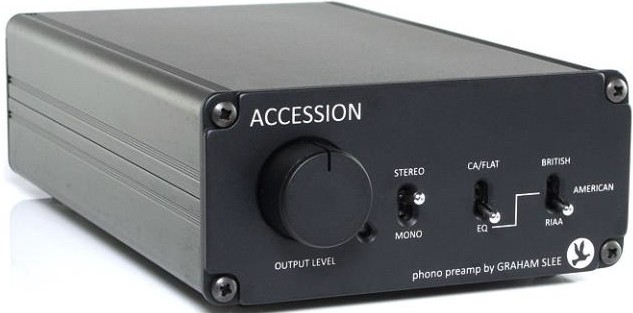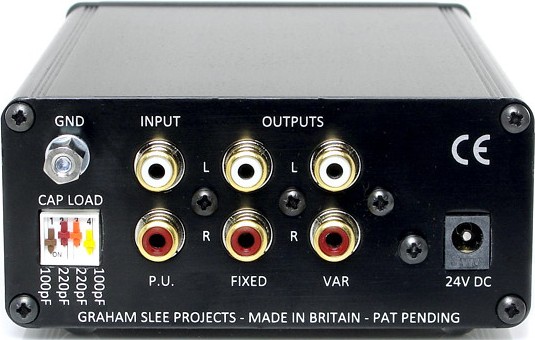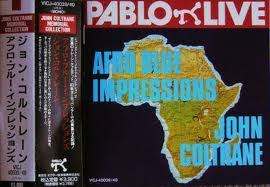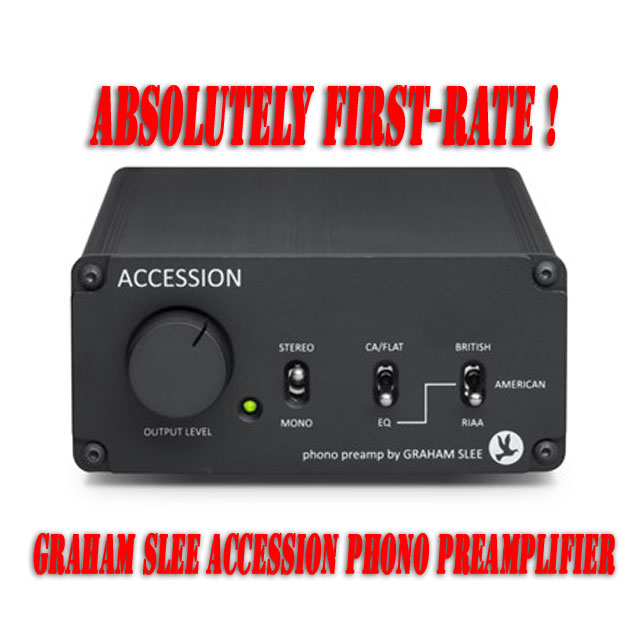Graham Slee Accession Phono Preamplifier
I’ve had a long, rewarding, and musically exalted experience with Graham Slee’s line of solid-state phono preamplifiers. I’ve reviewed 4 of them for the Stereo Times in the past (Gram Amp 2SE, Era Gold V, Reflex M, and Elevator EXP) and have found each of them to be reference-quality benchmarks in their individual price range. Yes – the ones to own.
 Like many of my favorite UK audio companies, Graham Slee’s products exude that air of technical perfectionism, results-based design and engineering, and a seeming no-nonsense simplicity that almost belies their uncompromised performance. The fact that the products are reasonably priced only adds to my esteem.
Like many of my favorite UK audio companies, Graham Slee’s products exude that air of technical perfectionism, results-based design and engineering, and a seeming no-nonsense simplicity that almost belies their uncompromised performance. The fact that the products are reasonably priced only adds to my esteem.
The Accession is Slee’s top phono preamp. Priced at $1450, it is a solid-state device with an outboard, dedicated power supply (the PSU-1). It is optimized for moving-magnet phono cartridges, and is unique in that it separates the cartridge’s equalization needs from that of the LP itself. Commonly, phono stages combine the 2 separate equalization demands into one overall circuit. The Accession breaks with this compromise, equalizing the cartridge first, before LP equalization is applied. This circuit design is exclusive to the Accession. Slee holds that this dual-stage EQ technique is the sine qua non of the Accession, a breakthrough in design so significant that it is protected by US Patent.

The Accession also features front-panel selectable EQ settings for some older LP equalization standards (English, American, and, of course, the current and now universal RIAA). One can also bypass EQ by switching to CA (Constant Amplitude) for use if converting the LP to digital and desirous of using one’s A/D converter to perform EQ functions. A stereo/mono switch is also available.

The rear panel features an additional set of outputs for driving a power amp directly, with volume controlled by a front panel knob. 4 switchable input capacitance values are available on the rear panel. The Accession is available in black or silver finishes.
Like all of Slee’s phono preamps, there is no on/off switch: the units are designed to be always on. It takes quite a long-time after connection for them to stabilize and reach optimum performance (as much as 48 to72 hours for fresh initial connection.) Consequently a quick on/off A/B comparison reviewing regimen is obviated. No great loss as far as my methodology goes, as changes noted in instantaneous comparisons fade in significance when compared to the musical and sonic results of long-term, more holistic listening.
 Graham Slee’s phono stages are engineered for maximum accuracy and ultimate resolution. They achieve this partly by incorporating ultra-wide bandwidth frequency response, perfectionist LP equalization, and the omission of any bass filtering. Sonically, their family signature includes high neutrality, accuracy, and transparency: each individual preamp limited only by the cost of the parts and circuitry practicable within its price point. The perfectionism of Slee’s approach results in a level of detail and musical communication out of reach for run-of-the-mill competitors in the same price category. Consequently they have served as perfect references and listening tools.
Graham Slee’s phono stages are engineered for maximum accuracy and ultimate resolution. They achieve this partly by incorporating ultra-wide bandwidth frequency response, perfectionist LP equalization, and the omission of any bass filtering. Sonically, their family signature includes high neutrality, accuracy, and transparency: each individual preamp limited only by the cost of the parts and circuitry practicable within its price point. The perfectionism of Slee’s approach results in a level of detail and musical communication out of reach for run-of-the-mill competitors in the same price category. Consequently they have served as perfect references and listening tools.
An unfortunate false dichotomy has arisen in popular understanding: that between ‘accuracy’ and ‘musicality.’ “Accurate” components, according to this sloppy mental short-hand, sound sterile, lifeless, and cerebral versus “musical” components which tend to euphonia and warm-puppy-ism. This dichotomy ignores the reality that our psychoacoustic perception and the physical facts of sound generation demand high accuracy to convince us that we are actually listening to music. A truly accurate component is automatically more musical. Viewed from this perspective, both “Accurate” and ”Musical” components are not only distorting the sound, they are also distorting the music.
The characteristics of a truly accurate component include speed: it must be able to track the fastest transient a musical instrument can produce. Thus its accelerative abilities are crucial. It must also have perfect brakes, as it must start and stop as quickly as the instrument. It must be able to track multiple levels of loudness simultaneously and accurately, as even a single plucked note contains multiple volume levels at the same time. Moreover, those levels diminish with the time the note is held. Time coherency is thus equally crucial: not only to preserve the integrity of that single note and its unique harmonic structure, but also to create the proper timing to the next note that follows. Thus, flow, melody, tempo, and rhythm can be coherently depicted.
Components that excel at this (partial) resume of requirements will feed directly into our psychoacoustic demands to produce the perception of music. We will be able to unambiguously identify where a sound is coming from in a sound field, what instrument is making that sound, what it is playing, and how it achieves what it is playing. All of Graham Slee’s phono stages that I’ve reviewed have excelled at these essentials of music reproduction. Each ascending phono stage in their line just does it that much better. The Accession, however, takes this ability to create the illusion of music to levels that approach the transcendent.
I enlisted the bulk of my turntable/arm/cartridge stable in my auditions, using both tube and solid-state amplification systems. Speakers were my now-classic Sound Lab Dynastats, which allow full bandwidth listening down to 22 Hz in my large concrete-floored listening room.
Although I used LP’s from a wide variety of musical genres, I used Classical music for my most demanding sessions. Classical music permits a rigorous comparison of the sound of a system to an “Absolute Sound.” Because so many different acoustic instruments are used, each with a unique timbre and tonal color, and are often so complexly and densely scored, Classical music is the acid test for the true abilities of any given component. Indeed, my own interest in and demand for ultimate high-performance audio was triggered by my immersion into Classical music when I was in my mid-20’s during the mid-1970’s. Systems and components that had seemed perfectly adequate with Rock, Pop, Folk, and Jazz, all too often fell on their faces when trying to distinguish, say, between the Cor anglais and the oboe, or the violin and viola, not to mention losing the plot when all the instruments were playing.
Once allowed to reach its optimum after AC connection, the Accession disappeared from awareness while listening. This was secondarily due to its unobtrusive size, but primarily due to its lack of colorations. Each instrument, regardless of its frequency range or complexity of harmonic structure, emerged as natural, complete, and uncolored, and was immediately identifiable. This natural clarity was available equally throughout the frequency range – basses as clear as triangles, acoustic guitars as clear as violins, soprano saxes as clear as clarinets. There were no sins of commission or omission. This indicates the Accession’s exceptional speed: it was never flummoxed, neither by intensely hard initial transients nor by the gentlest of instrumental touch.
The Accession’s dynamic tracking was also first-rate: each note in an instrumental line given its proper varying volume to reveal the line’s melodic and expressive intent. Thus phrasing, punctuation, and rhythm were also exceptionally clear.
Outstandingly, the Accession was able to sustain its superb dynamic tracking regardless of how many instruments were playing. Instruments changing volume from foreground to accompaniment, quiet instrumental passages offering the subtlest of comments on another instrument’s line, the relative volume of each instrument in an ensemble: all of these crucial musical expressions were handled with a grace and clarity that I’ve yet to hear bettered.
Because each instrument’s timbre and sonic signature was produced so accurately and the musical technique of its playing so readily accessible to perception, the Accession’s ability to allow following each and every instrument, no matter how dense and complex the scoring, was absolutely top-drawer. Truly, I’ve never heard this done better.
 The sheer beauty of the sound of many instruments (regardless of what they were playing) was reproduced with a natural ease that bordered on the ravishing. Musical communication and revealing of emotional and artistic affect led to the repeated experience of hair rising on the back of the neck, chills down the backbone, and the beginning of welling of tears. It didn’t make any difference if the music was Duane Allman’s guitar work on Dreams, Hugh Bean’s violin on The Lark Ascending, John Coltrane’s sax lines on Afro Blue and Alabama, or Steve Winwood’s voice on Sea of Joy. The Accession delivered the emotional and artistic message of the music intact.
The sheer beauty of the sound of many instruments (regardless of what they were playing) was reproduced with a natural ease that bordered on the ravishing. Musical communication and revealing of emotional and artistic affect led to the repeated experience of hair rising on the back of the neck, chills down the backbone, and the beginning of welling of tears. It didn’t make any difference if the music was Duane Allman’s guitar work on Dreams, Hugh Bean’s violin on The Lark Ascending, John Coltrane’s sax lines on Afro Blue and Alabama, or Steve Winwood’s voice on Sea of Joy. The Accession delivered the emotional and artistic message of the music intact.
Although I own upwards of 12,000 LP’s, 99.95% of them are stereo and equalized to the RIAA standard. Consequently, I could make no use of the Accession’s EQ flexibility. Furthermore, since I have no plans to ever convert my LPs to digital, the Accession’s ‘CA’ feature was also moot.
I was, however, intrigued by the Accession’s ability to bypass an active preamp and run directly into a power amp. My experience with ‘passive’ preamps, dating back to the 1990’s when they first appeared, to my most recent auditions, has proven largely disappointing. While at times offering a new-found transparency to the mids and highs, I’ve mostly encountered a loss of bass dynamics and a loss of rhythmic brio and drive. Consequently I’ve always preferred active pre-amplification to drive the power amp.
It took quite a bit of phenomenological ‘bracketing’ to overcome my past experiences. I first tried the Accession variable output connection into NuForce’s STA200 solid-state power amp. Known as the ‘Baby Goldmund’ in some circles, the STA 200 offers an unusually high 35 dB of gain along with its ultra wide bandwidth, dynamic bass punch, and high transparency. Running the Cartridge Man’s MusicMaker III, Classic, and MusicMaster (.4 mV output) moving-iron phono cartridges into the Accession allowed me to achieve more than adequate SPL’s without foraying beyond the 10 to 12 o’clock positions on the volume knob.
While bass punch and dynamics were not compromised, I did not experience any revelations in mid and high frequency transparency, as it was already superb in ‘active preamp’ mode. In short it was not a “Eureka! I have found it!” moment. I could not forestall the intuition that perhaps a more transparent and simpatico interconnect would have yielded better results, but it was clear that to successfully incorporate the Accession into a dedicated no-preamp system would require sincere and literal dedication.
Further auditioning with the Meitner STR55 Plus and the PrimaLuna Prologue Five amps confirmed that direct connection was indeed workable and a valid alternative to use of an active preamplifier. But I found that I much preferred the Accession running into the PrimaLuna Dialogue Premium active line stage.
 Working through my vast stable of different arms, tables, and cartridges showed the Accession’s transparency to the source to be as exalted as the rest of its performance virtues. Each improvement in the front end yielded immediate improvement in results. Significantly, each front-end hit its peak both sonically and musically: I’ve never heard any of them sound better. Though the Accession pays special attention to the demands of moving-magnet cartridges, I found it equally terrific when using moving-iron, high output MC’s, or low output MC’s (I added Slee’s superb Elevator EXP for low-output MC duties.) Want to know if spending $12,000 on an ultimate turntable and arm is a rational decision? Run it through the Accession and your investment will seem a bargain. Similarly want to know if that dumpster refugee mid-70’s Japanese Direct-Drive was discarded by accident? The Accession will tell you.
Working through my vast stable of different arms, tables, and cartridges showed the Accession’s transparency to the source to be as exalted as the rest of its performance virtues. Each improvement in the front end yielded immediate improvement in results. Significantly, each front-end hit its peak both sonically and musically: I’ve never heard any of them sound better. Though the Accession pays special attention to the demands of moving-magnet cartridges, I found it equally terrific when using moving-iron, high output MC’s, or low output MC’s (I added Slee’s superb Elevator EXP for low-output MC duties.) Want to know if spending $12,000 on an ultimate turntable and arm is a rational decision? Run it through the Accession and your investment will seem a bargain. Similarly want to know if that dumpster refugee mid-70’s Japanese Direct-Drive was discarded by accident? The Accession will tell you.
Determining the ultimate capability of a component is perhaps the most difficult reviewing task. We all know that any system’s ultimate potential is limited by the performance of its weakest link. Determining what that weakest link is can be frustratingly difficult to accurately identify. This is particularly true when the system is tonally and dynamically neutral, balanced, and offers low artistic distortion: i.e., it truly makes music. The Accession never showed the slightest hint of being a weakest link.
The Accession offers an unusually clear and transparent window of the front end driving it and thus presents a reliable picture of front end quality. It does this with an ease and grace that smacks more of the characteristics of great artistry than mere technical brilliance. Analogue LP presents the Gold Standard in reproducing subtlety and low level detail. Cue up a naturally recorded orchestral LP and just after the lead-in grooves you immediately hear the sound of the hall, followed by the instruments imbedded in and emerging from within its overall acoustic.
 This instantaneous orientation to the recorded venue, coupled to accurate timbral reproduction, eliminates most of the fatigue, both conscious and unconscious, associated with listening to music on a hifi system. The Accession proved to be the easiest to listen to of any phono stage I can recall: I emerged from each listening session satisfied, refreshed, and deeply aesthetically moved, often to the point of ecstasy.
This instantaneous orientation to the recorded venue, coupled to accurate timbral reproduction, eliminates most of the fatigue, both conscious and unconscious, associated with listening to music on a hifi system. The Accession proved to be the easiest to listen to of any phono stage I can recall: I emerged from each listening session satisfied, refreshed, and deeply aesthetically moved, often to the point of ecstasy.
The Accession is an absolutely first-rate phono stage and an absolutely first-rate music maker. It merits the highest of recommendations.

![]()
paul szabady
Accession Phono Preamp Specifications
– Input and output connectors: 360° shielded RCA/phono sockets, hard gold plated
– Input sensitivity range: 1.6mV to 7.2mV (recommended)
– Output range (for above inputs): 190mV to 857mV
– Maximum input: 35mV rms
– Maximum output: 5.2V rms
– Gain: 41.5dB (119) at 1kHz
– Input impedance: 47k Ohms plus: 100pF / 220pf / 320pf / out
– Output impedance (driving impedance): 750 Ohm fixed / 470 Ohm variable (will drive 10k Ohms and above)
– Noise at output: -66dB Quasi-peak 20Hz to 20kHz
– Distortion: typically 0.01% 20Hz to 20kHz
– RIAA accuracy: ± 0.3dB
– Frequency response: – Channel balance: 0.2dB
– Channel separation: 60dB
– Power supply: Remotely powered using PSU1 linear power supply
– Size (approx.): W: 107 x H: 50 x D: 195 (mm) inc. jacks
Price: $1450.00 USA
Note: Specifications subject to alteration without notice in keeping with continuous improvement policy.
Manufacturer
Graham Slee
HiFi System Components Limited
6 Buttercross Drive
Little Houghton, S72 0HS
England
+44 (0) 1909 568739
+44 (0) 7947 107188
+44 (0) 1226 755328
e-mail: gsp.ltd@gspaudio.co.uk
website: www.hifisystemcomponents.com
twitter: twitter.com/gspaudio
US Distributor:
LP Gear
3024 Via Venezia
Henderson, NV 89052 US
Fax: (725) 888-4711
https://www.lpgear.com/SFNT.html
Stereo Times Masthead
Publisher/Founder
Clement Perry
Editor
Dave Thomas
Senior Editors
Frank Alles, Mike Girardi, Russell Lichter, Terry London, Moreno Mitchell, Paul Szabady, Bill Wells, Mike Wright, and Stephen Yan,
Current Contributors
David Abramson, Tim Barrall, Dave Allison, Ron Cook, Lewis Dardick, John Hoffman, Dan Secula, Don Shaulis, Greg Simmons, Eric Teh, Greg Voth, Richard Willie, Ed Van Winkle, Rob Dockery, Richard Doran, and Daveed Turek
Site Management Clement Perry
Ad Designer: Martin Perry







Be the first to comment on: Graham Slee Accession Phono Preamplifier